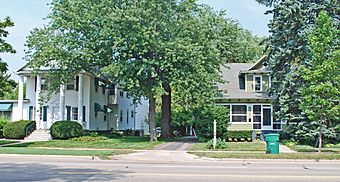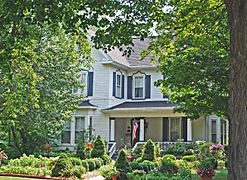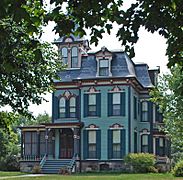East Michigan Avenue Historic District facts for kids
Quick facts for kids |
|
|
East Michigan Avenue Historic District
|
|

Houses on East Michigan
|
|
| Location | 300-321 E. Michigan Ave., 99-103 Maple St., and 217, 300 and 302 E. Henry, Saline, Michigan |
|---|---|
| Area | 16 acres (6.5 ha) |
| Architect | Multiple |
| Architectural style | Colonial Revival, Bungalow/craftsman, Late Victorian |
| MPS | Saline MRA |
| NRHP reference No. | 85002953 |
| Added to NRHP | October 10, 1985 |
The East Michigan Avenue Historic District is a special neighborhood in Saline, Michigan. It's a collection of old houses and other buildings. These buildings are important because of their history and unique architecture. This district was added to the National Register of Historic Places in 1985. This means it's recognized nationally for its historical value.
Contents
What is a Historic District?
A historic district is an area with a group of buildings. These buildings are important because of their history or special design. They are protected to keep their original look and feel. The East Michigan Avenue Historic District covers about 16 acres. It includes houses on East Michigan Avenue, Maple Street, and East Henry Street.
Homes in the District
The East Michigan Avenue Historic District has eighteen houses. It also has nine barns and carriage houses. These buildings were mostly built between 1870 and 1920. You can see many different building styles here. These include Queen Anne, Second Empire, Colonial Revival, and Bungalow styles.
Many houses on Michigan Avenue and Maple Street look similar. They have wide lawns and are set back from the street. A builder named Elwood Rogers built several of them. He used Queen Anne or Colonial Revival styles. This gives the area a nice, uniform look. The houses on Henry Street are also very special. They are included because of their amazing design.
Special Houses to See
Some houses in the district are especially important. Here are a few examples:
Max Fosdick House (303 E. Michigan)
This house is a great example of a bungalow style home. It was built in 1917 or 1918. Max Fosdick, who worked for Detroit Edison, lived here. The house has a roof that slopes down towards the street. It covers a porch that runs across the front. There's also a small window in the roof, called a dormer.
Willis M. Fowler House (315 E. Michigan)
Built in 1911, this house was made by builder Elwood Rogers. It was for William Fowler, a real estate businessman. The house has a sloped roof with projecting gables. These gables have fan-shaped windows.
George Seeger House (101 Maple)
This Colonial Revival style house was built in the early 1900s. Elwood Rogers also built this one. It was for George Seeger, whose father was a well-known farmer. The house has a steeply sloped roof. It also has a rounded porch that wraps around the front.
Beverly Davenport House (302 E. Henry)
This house was built in 1873. A Detroit architect named J.J. Smith designed it. It was for Beverly Davenport, the son of a local businessman. Beverly later became a bank president. The house has a unique Second Empire style. It features a special roof type called a mansard roof.
William H. Davenport House (300 E. Michigan)
This house was designed by architect William Scott. It was built in 1876 for William Davenport, a very important businessman. This house is so special that it's listed on the National Register by itself. It has a slate mansard roof and a corner tower. You can see many fancy decorations on the outside.
Gallery
Template:National Register of Historic Places listings in Washteness County, Michigan



